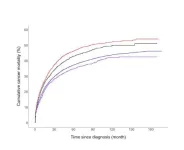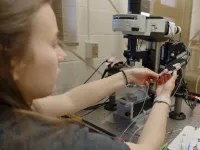(Press-News.org) Hispanic and non-Hispanic Black female survivors of breast cancer experience higher death rates after being diagnosed with a second primary cancer than members of other ethnic and racial groups, according to recent research from investigators at the Johns Hopkins Kimmel Cancer Center.
In a study of nearly 40,000 adult survivors of breast cancer, the risk of death from a second cancer was 12% higher among non-Hispanic Black survivors and 8% higher among Hispanic survivors compared with non-Hispanic white survivors. Survivors in racial and ethnic minorities were diagnosed with second cancers up to six years younger than non-Hispanic white survivors, and within a shorter time from their first cancer.
Additionally, non-Hispanic Black survivors had a 44% higher risk of cardiovascular disease-related death after a second cancer diagnosis than non-Hispanic white survivors. These results were published March 9 in the Journal of the National Cancer Institute.
Nearly half of cancer survivors live for more than 10 years, and approximately one in five people diagnosed with cancer has a prior cancer history, according to the National Cancer Institute. Therefore, says senior study author Kala Visvanathan, M.D., M.H.S., director of the Cancer Genetics and Prevention Service at the Kimmel Cancer Center and a member of the Women’s Malignancy Program at Johns Hopkins, it’s important to determine risk factors associated with second cancers so they can best be prevented, or diagnosed and managed as early as possible.
There could be many contributing factors to the poor survival observed after a second cancer, including diagnosis of aggressive tumors, cumulative treatment and type of treatment received, lifestyle factors and social determinants of health, says Visvanathan, who is also director of the cancer epidemiology track at the Johns Hopkins Bloomberg School of Public Health.
“We believe this to be one of the first studies to comprehensively examine the racial and ethnic disparities in survival outcomes after a second cancer,” Visvanathan says. “The findings are extremely concerning given the increasing prevalence of second cancer at a young age among women diagnosed with breast cancers. A multipronged approach is needed to identify biological factors, and patient-, provider- and systems-level contributors to survival outcomes among breast cancer survivors.”
Zhengyi Deng, Ph.D., a former doctoral student at the Bloomberg School of Public Health, was the study’s lead author. The research team evaluated information from 39,029 adult female survivors of breast cancer who developed a second primary cancer in 2000–2014, as recorded in the national Surveillance, Epidemiology and End Results (SEER) 18 Program database. The database, maintained by the National Cancer Institute, covers 18 U.S. cancer registries and represents nearly 28% of the population. Participants were followed until Dec. 31, 2016, or at least two years after the second cancer diagnosis.
Participants’ ethnicity was categorized as Hispanic, non-Hispanic Asian, non-Hispanic Black and non-Hispanic white. Non-Hispanic American Indian or Alaska Native, and Pacific Islander, were excluded from study due to a small number of records. Investigators looked at several variables, including five-year survival rate; demographics including age and year of diagnosis, marital and insurance status, and initial treatments; median household income and education level; and cause of death.
Overall, there were 39,029 second cancers and 15,117 deaths after second cancers. The strongest associations with cancer deaths were among non-Hispanic Black survivors with a second breast or uterine cancer and among Hispanic survivors with a second breast cancer. Secondary cancers occurred at an earlier age in Hispanic (mean age: 62.2), non-Hispanic Asian (mean age: 63.4) and non-Hispanic Black (mean age: 63.5) survivors compared with non-Hispanic white survivors (mean age: 68.8).
Breast cancer was the most common second cancer across all racial and ethnic groups, followed by lung, colorectal and uterine cancer. Second cancers in non-Hispanic Black women were less likely to be diagnosed at a local stage compared with other groups. And, Hispanic and non-Hispanic Black survivors were more likely than members of other groups to need chemotherapy for their first and second cancer.
Looking at cancer mortality, non-Hispanic Black survivors had the highest cumulative mortality during the entire follow-up, followed by Hispanic, non-Hispanic white and non-Hispanic Asian survivors. Later stage at presentation and more aggressive tumor characteristics contributed to increased cancer mortality among Hispanic and non-Hispanic Black survivors after second cancers.
A prior study from the team, the results of which were published last summer in NPJ Breast Cancer, found that cancer survivors with a second cancer had a 27% increased risk of cancer death and 18% increased risk of death from any cause compared to survivors with primary cancers. The research team is continuing studies of patients with second cancers.
Study co-authors were Miranda Jones, Mei-Cheng Wang and Antonio Wolff of Johns Hopkins. The work was supported by the Breast Cancer Research Foundation. Visvanathan received research funding from Cepheid and holds a patent. Wolff also holds a patent. The Johns Hopkins University is managing these relationships in accordance with its conflict-of-interest policies.
END
Black, Hispanic survivors of breast cancer have higher death rates from second cancers
2023-06-09
ELSE PRESS RELEASES FROM THIS DATE:
Mouse models of adolescent binge drinking reveal key long-lasting brain changes
2023-06-09
UNIVERSITY PARK, Pa — Heavy alcohol consumption may cause permanent dysregulation of neurons, or brain cells, in adolescents, according to a new study in mice. The findings suggest that exposure to binge-levels of alcohol during adolescence, when the brain is still developing, lead to long-lasting changes in the brain’s ability to signal and communicate — potentially setting the stage for long-term behavioral changes and hinting towards the mechanisms of alcohol-induced cognitive changes in humans.
“What we’re seeing here,” said Nikki Crowley, assistant professor in biology and biomedical engineering ...
Infants and toddlers up to 5 years old can participate in Shape Up! Keiki study at Pennington Biomedical
2023-06-09
The Pennington Biomedical Research Center is looking for children 5 years old and younger to participate in the Shape Up! Keiki research study. The purpose of the Shape Up! Keiki research study is to create a better way to measure and describe health from body shape.
“Parents can learn more about their child’s health by joining the Shape Up! Keiki study, while also providing important information that will help us find quick ways to measure obesity status and health based on a child’s body ...
Seenu Hariprasad named University of Chicago Chair of Ophthalmology and Visual Science
2023-06-09
Seenu M. Hariprasad, MD, the Shui-Chin Lee Professor of Ophthalmology, will be appointed Chair of the Department of Ophthalmology and Visual Science, effective July 1, 2023. He has been serving as Interim Chair since 2020.
Hariprasad is an internationally recognized vitreoretinal surgeon who originally joined the University of Chicago in 2005. Over the course of his career, he has developed a strong track record as a clinician, surgeon, researcher, educator, and leader in his department. He is a leading specialist in various vitreoretinal disorders, including macular degeneration, diabetic ...
Liquid metal sticks to surfaces without a binding agent
2023-06-09
Everyday materials such as paper and plastic could be transformed into electronic “smart devices” by using a simple new method to apply liquid metal to surfaces, according to scientists in Beijing, China. The study, published June 9 in the journal Cell Reports Physical Science, demonstrates a technique for applying a liquid metal coating to surfaces that do not easily bond with liquid metal. The approach is designed to work at a large scale and may have applications in wearable testing platforms, flexible devices, and soft robotics.
“Before, we thought that it was impossible for liquid metal ...
Estimated reductions in opioid overdose deaths with public health interventions
2023-06-09
About The Study: In this decision analytical model study of the opioid epidemic in four U.S. states, sustained implementation of interventions, including increased delivery of medications for opioid use disorder and naloxone supply, was found to be needed to reduce opioid-related overdose deaths and prevent deaths from increasing again.
Authors: Jagpreet Chhatwal, Ph.D., of Massachusetts General Hospital in Boston, is the corresponding author.
To access the embargoed study: Visit our For The Media website at this link https://media.jamanetwork.com/
(doi:10.1001/jamanetworkopen.2023.14925)
Editor’s Note: Please see ...
Racial, ethnic, sex differences in methadone-involved overdose deaths before, after federal policy change expanding take-home methadone doses
2023-06-09
About The Study: In this study of monthly methadone-involved overdose deaths, the take-home policy may have helped reduce deaths for Black and Hispanic men but had no association with deaths of Black or Hispanic women or white men or women. The urgency of the overdose crisis requires that national methadone policy debates and decisions address the heterogeneity of people in treatment; relaxing methadone restrictions may help some particularly at-risk groups.
Authors: Rebecca Arden Harris, M.D., M.Sc., of the University of Pennsylvania in Philadelphia, is the corresponding author.
To ...
Graphene-based Carbocatalysts: Synthesis, Properties, and Applications—Beyond Boundaries
2023-06-09
Introducing "Graphene-based Carbocatalysts: Synthesis, Properties, and Applications (Volume 2)"—a concise yet comprehensive compendium for the scientific community, professors, and students alike. This authoritative volume - published by Bentham Science - delves into the forefront of Graphene-based carbocatalysis, providing a wealth of factual knowledge and exploration. The book opens with an in-depth analysis of electrocatalysis by Graphene materials, unraveling the intricate relationship between Graphene and electrochemical reactions. It sheds light on the catalytic prowess exhibited by Graphene-based materials, offering promising avenues for advancing energy ...
Aston University wins £1.8m to boost West Midlands low carbon markets
2023-06-09
Aston University and local industry to develop technology to convert organic material into commercially valuable products
Sawdust, diseased trees and dried chicken litter among what can be transformed into sustainable bioproducts
West Midlands companies are invited to join a cluster to develop new low carbon products for growing markets.
Aston University is to receive £1.8 million to transform the West Midlands into a powerhouse of low-carbon product development and commercialisation.
The University will be building on its existing research facilities to lead the region’s Biochar CleanTech Accelerator as part of the West Midlands Innovation Accelerator.
The project ...
Price vs. health: Food shoppers choose price
2023-06-09
Key Takeaways:
When food consumers are properly incentivized, they will choose healthier options.
When financial incentives are removed, consumers are more likely to choose less healthy options by comparison.
BALTIMORE, MD, June 9, 2023 – A new study of food consumer shopping behaviors has found that when faced with a choice – lower prices or healthier foods – they will likely choose lower prices.
The study found that when you give food consumers temporary incentives to buy ...
Advances in eco-friendly gas insulating medium for next-generation SF6-free equipment
2023-06-09
Gas-insulated equipment (GIE) that utilizes the most potent greenhouse gas sulfur hexafluoride (SF6) as insulation and arc-quenching medium has been widely used in the power industry. Seeking eco-friendly insulating gas with advanced performance for next-generation SF6-free GIE is significant for the “net-zero” goal and sustainable development.
A research team led by Xiaoxing Zhang of Hubei University of Technology in China and scientists from Wuhan University, Southeast University, North China Electric Power University, Université de ...





